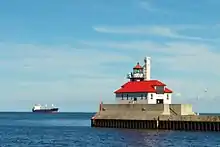Duluth South Breakwater Outer Light
The Duluth South Breakwater Outer Light is a lighthouse on the south breakwater of the Duluth Ship Canal in Duluth, Minnesota, United States.[2][3][4] It forms a range with the Duluth South Breakwater Inner Light to guide ships into the canal from Lake Superior.
 The Duluth South Breakwater Outer Light from the northwest | |
| Location | Lake end of south breakwater of the Duluth Ship Canal, Duluth, Minnesota |
|---|---|
| Coordinates | 46°46′48.3″N 92°5′16″W |
| Tower | |
| Constructed | 1874 |
| Foundation | Concrete pier |
| Construction | Brick |
| Automated | 1976 |
| Height | 10.5 m (34 ft) |
| Shape | House with square tower |
| Markings | White with red roof |
| Heritage | National Register of Historic Places listed place |
| Fog signal | Horn |
| Light | |
| First lit | 1901 |
| Focal height | 44 ft (13 m) |
| Lens | Fourth order Fresnel lens |
| Range | 13 nautical miles (24 km; 15 mi) |
| Characteristic | Fixed Green |
Duluth Harbor South Breakwater Outer Light | |
| Area | Less than one acre |
| Architect | Office of the Superintendent of Lighthouses |
| MPS | Light Stations of the United States MPS |
| NRHP reference No. | 16000341[1] |
| Added to NRHP | June 7, 2016 |
History
The appropriation which paid for the initial construction of this light was made in 1870, with the intent to build a structure at the end of the Northern Pacific Railroad docks.[5] Storm damage, however, delayed construction until 1872, by which point the canal had been dug.[5] A wooden pyramidal tower was erected, initially equipped with a fifth-order Fresnel lens.[4] An elevated walkway led back down the pier; a frame dwelling for the head keeper was constructed nearby, with the assistants required to look for lodging elsewhere in the city. This tower was first lit in 1874.[4][5]
The area is notoriously foggy, and an automated bell taken from the South Manitou Island Light—the first in a long series of fog signals—was installed in 1880.[5] This was replaced by a pair of steam-powered whistles in 1885, housed in a newly constructed shelter on the breakwater.[4] The noise from these whistles brought complaints from city residents, so a parabolic reflector mounted in a sawdust-filled box was installed in a successful effort to direct the sound out towards the lake.[4] Fog signal operation, it may be noted, averaged 472 hours a year for the first ten years of operation; in 1895 the whistles blew for 1,048 hours, an average of over four hours a day over the eight-month season.[4][5]
In 1886 the lens was upgraded to a fourth-order Fresnel lens, and the characteristic changed from a red and white flash to a fixed red signal.[5]
The late 1890s reconstruction of the ship canal resulted in the replacement of this tower and the fog signal house with a single brick lighthouse containing both signals.[5] This house, constructed of Cream City brick, was completed in 1901, and the new tower was first lit on September 1 of that year.[4] This tower stood on the southeast corner of the rectangular building, and housed the lens retained from the old light; the fog whistles and their reflector were also moved from the old structure to the new.[4][5] The latter were replaced in 1915 with locomotive whistles,[4] and in 1921 with Type F diaphones, setting off another round of noise complaints, which led to the installation of a new sound reflector. The diaphones were replaced in 1968 with an electronic horn,[4] but in 1976 a group styling itself TOOT (for "reTurn Our Old Tone") began a campaign to restore the fog signal.[5] Horns from the Kewaunee Pierhead Light were obtained,[4] and in 1995 the diaphones were put back in service, eliciting, of course, a new round of noise complaints, which led to restriction of the signal to daytime operation.[5] The signal required a three-phase current supply for operation, and when this failed in 2005, the Coast Guard refused to pay for repairs; legal concerns led the city to refuse to pick up the tab, and the signal was dismantled the following year.[5] The light, however, continues in service, displaying a fixed green light.[2]
The South Breakwater Outer Light was listed on the National Register of Historic Places in 2016 for its local significance in the themes of engineering, maritime history, and transportation.[6] It was nominated for its association with federal efforts to establish nationwide navigational aids, and for being characteristic of early-20th-century harbor breakwater lights built around the Great Lakes.[7]
See also
References
- "National Register Information System". National Register of Historic Places. National Park Service. July 9, 2010.
- Light List, Volume VII, Great Lakes (PDF). Light List. United States Coast Guard. 2012. p. 150.
- "Historic Light Station Information and Photography: Minnesota". United States Coast Guard Historian's Office. Archived from the original on 2017-05-01.
- Pepper, Terry (2003-12-17). "Duluth Rear Range Light". Seeing the Light: Lighthouses of the western Great Lakes. Retrieved 2019-05-05.
- Anderson, Kraig (2019). "Duluth Harbor South Breakwater Outer, MN". Lighthousefriends.com. Retrieved 2019-04-20.
- "Duluth Harbor South Breakwater Outer Light". National Register of Historic Places Program. National Park Service. Retrieved 2019-05-05.
- Koski-Karell, Daniel; Leigh Cutler (2016-02-11). "National Register of Historic Places Registration Form: Duluth Harbor South Breakwater Outer Light" (PDF). National Park Service. Retrieved 2019-05-05.
External links
 Media related to Duluth South Breakwater Outer Light at Wikimedia Commons
Media related to Duluth South Breakwater Outer Light at Wikimedia Commons


